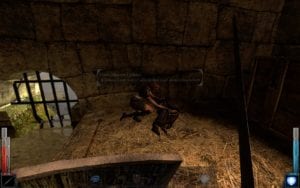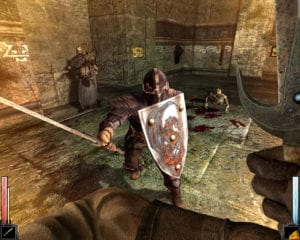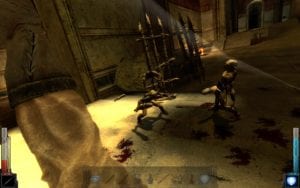Hello, readers of the Fandomentals. Last time, I took you on a trip down the memory lane about the Heroes of Might and Magic series. This time, I will talk about a game that shares a universe with the fifth, sixth, and seventh game of that franchise, but in an entirely different genre: Dark Messiah of Might and Magic.
Dark Messiah is a first-person action game with RPG elements. The franchise started with RPGs, of course, but nothing like this. While the game is far from perfect, I think it deserves more consideration than it gets. It does have some special things going for it.
Our protagonist in this game is Sareth. A young man, studying under the wizard Phenrig. He’s…well, if he sounds generic that’s because he is. We never even see his face, though due to how the game’s camera works we do see his lower body and hands. He has a mysterious past, of course, and it plays into the plot of the game.
The tutorial has him retrieve the Shantiri Crystal, a source of magic power. Phenrig then sends him on a mission to help a colleague of his, Menelag. He seeks an artifact with a very original name, Skull of Shadows. But he can’t find it without the very crystal Sareth just found.
Thus his mission becomes to bring the crystal to him and aid him in the search. Phenrig summons a strange woman out of nowhere, who introduces herself as Xana and seemingly takes residence inside Sareth’s head. She proceeds to play mission control, which is to say tell us what to do and where to go. As well as make lewd and suggestive comments with some frequency.
Of course, as soon as Sareth arrives in the city of Stonehelm, where Menelag resides, the city comes under attack from necromancers. We have to fight them off first, but then we get to meet the wizard and his niece, Leanna. Things aren’t going to be as simple as just sailing off, though…

What follows is exploration, fights, delving into Sareth’s origins, a nice girl/bad girl dynamic with Xana and Leanna and all that. It’s not a very original story but it does little to offend, either. It’s simply not what you come to the game for. And as I said in my Heroes article, the setting is paper-thin. Let’s focus on what we really do come to the game for.
And what people come here for is the action. Dynamic, first-person action with sword-fighting, spell-slinging, throwing enemies around and using your environment. We travel from a fairly typical fantasy city to its catacombs, then to an island and expansive tunnels within it, and finally into a necropolis.
As I’ve mentioned, we have the option to customize Sareth’s skills like in an RPG game. The three trees are combat skills, magic spells and miscellaneous. This third category incorporates awareness, stealth and passive bonuses to health or mana.
All in all, a fairly standard set, falling into the “warrior, mage, rogue” schema. Mostly, anyway. Playing as a purely stealthy character isn’t, in my experience, entirely viable. While you can take out enemies from stealth or avoid them entirely, you’re going to have to fight eventually. And of course we can mix and match skills as we please. Even a warrior Sareth wants to have a healing spell, for instance.
Another distinctly RPG-like element is equipment. Which is, mercifully, sparse and utilitarian. There’s several types of weapons that have different functions. Swords are the most straightforward option, paired with shields. Daggers are quicker and can instantly kill unaware enemies if we’ve trained in stealth. Staves are slower but can hit multiple enemies. Bows are the ranged non-magical attack option. Although daggers work well with stealth and some staves require magical skill to use, wielding all kinds of weapons is possible and encouraged.
Something I should mention here is crafting. Normally, it’s anathema to me and everything I hold dear. Here, there’s no crafting skills or anything. But you can make two swords by yourself. First is a simple steel sword, then it’s a fiery one out of a special material. You do it by picking up a metal bar, then taking it to a forge and interacting with the tools in the right order. Heat it up, cool it, hammer, sharpen…it’s a small thing, but fun and immersive.
Unlike in many RPGs, magic is actually fairly exciting to use. It feels more visceral than the usual “point, click and watch magic happen” far, and can be used to affect the environment. Fire spells can set it aflame. The ice spells can not only freeze enemies but also create slippery surfaces to make them fall – possibly plunging into some abyss. Telekinesis can throw objects at them, or sometimes even grab and throw enemies themselves. It’s as fun as it sounds.

It doesn’t take magic to manipulate the environment, though. Its use in combat is arguably the game’s major selling points. Sareth can pick and throw objects, kick them and enemies, shoot arrows at weak spots and the like.
Needless to say, it all requires some suspension of disbelief. The areas where fight enemies just so happen to have spiked surfaces we can kick them onto. Which kills them instantly, even if they wear metal armor that should stop the spikes entirely. There’s also plenty of seemingly empty crates and barrels placed on shelves which are supported by rickety beams we can kick and watch the whole thing fall. Everyone also seems to have a surplus of flasks containing flammable oil.
Enemies themselves appear to be far lighter than adult humans or orcs should be, and Sareth’s kicks send them flying like rag dolls. And there’s plenty of bottomless pits for them to fall into. They’re also all highly flammable whenever they come into contact with any source of fire.
Still, it’s all part of the fun, isn’t it? We just have to accept it as elements of the convention. When you combine it with the variety of weapons and spells to play with, combat becomes a dynamic affair that offers a lot of replay value. You can just wade in swinging…or kick a support to send things toppling on your enemies. Or kick them into a fire. You can also make the floor slippery. Or…you get the idea.
Different enemies will require different strategies, though it’s not all that complex. Humans and animals are vulnerable to fire, so using spells and weapons with that element works well. Orcs, goblins and cyclopes resist fire, so lightning is a better option. Undead aren’t actually vulnerable to fire, somewhat uncommonly. They’re weak against “holy” weapons, but we won’t get those until the very end.
Enemies will also use somewhat different tactics. Our early foes will be human mercenaries, who straightforwardly attack us with swords and bows. They fight somewhat cautiously, parrying blows and trying to get past our defenses. Orcs are far more aggressive and stronger than them. Goblins are weak and stupid, but they attack in numbers – the game actually gives a very real feeling of how they just keep on coming out of nowhere. Cyclopes are the game’s go-to boss fights; we’ll fight them on several occasions as necromancers use undead versions. Fighting them tends to involve using the environment to our advantage.

Undead will likewise test our ability to use our surroundings. Zombies are slow, but they spit annoying poison and more importantly, get up after we defeat them. We have to impale them on the ground, set them on fire or use the environment – which kills them for good. Easier said than done when a dozen of them is after us. Ghouls, which we encounter later on, stay dead the first time, but are shockingly durable. Using the environment is often simpler than just fighting them.
When we’re not fighting, we’re exploring. Which is fairly standard first-person action fare. There’s traps to avoid and secrets to find. But, again, the environment is responsive to us and there’s plenty to break and destroy. At one point we get our hands on a bow that shoots rope arrows – when they hit wooden surfaces, they drop a rope. It’s a trick that resembles stealth game and we’ll be using it a great deal.
As a side note…the game offers a multiplayer mode. I can’t tell you much about it. I’ve tried it, but it has a very fast pace and steep learning curve. Perhaps it’s enjoyable, but by now I doubt the servers are still functioning and not empty.
The game isn’t long, nor are the enemies and environments that numerous. But it’s still a fun fantasy romp that shows us first-person fantasy is possible. And that it can be fun and dynamic. Different ways of playing your character – sword, magic, stealth – actually feel fairly different. The world feels responsive to your efforts.
It’s not a groundbreaking game, but it was a stepping stone for its creators to move on to more notorious and famous ones. And it has plenty to offer even now. I encourage you to delve into this somewhat forgotten bit of gaming history.

